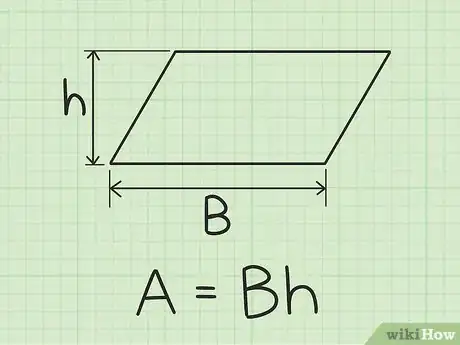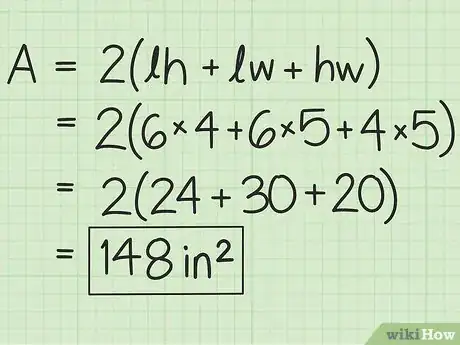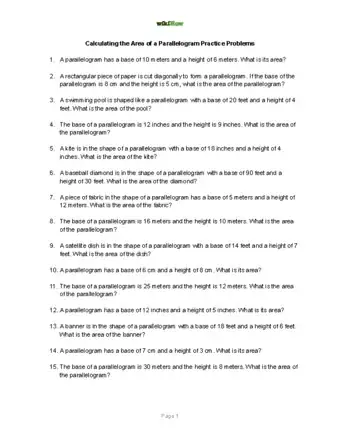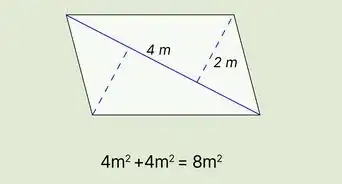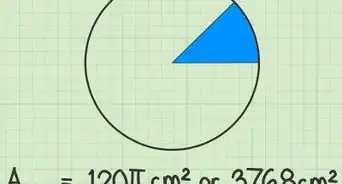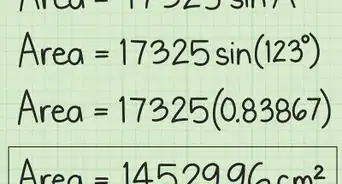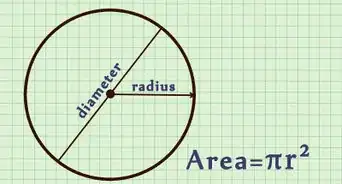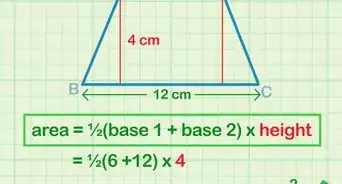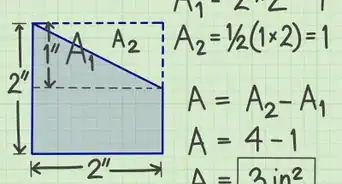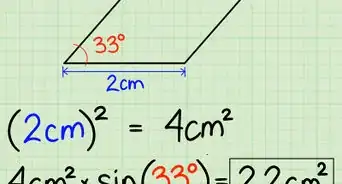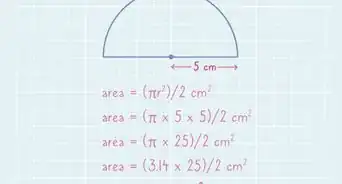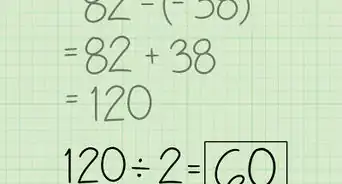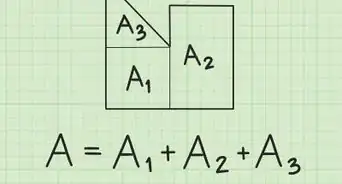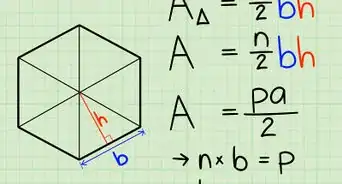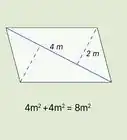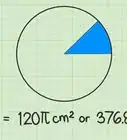This article was co-authored by wikiHow Staff. Our trained team of editors and researchers validate articles for accuracy and comprehensiveness. wikiHow's Content Management Team carefully monitors the work from our editorial staff to ensure that each article is backed by trusted research and meets our high quality standards.
There are 9 references cited in this article, which can be found at the bottom of the page.
This article has been viewed 93,756 times.
Learn more...
A parallelogram is a quadrilateral, or four-sided shape, with two sets of parallel sides. Squares, rectangles, and rhombuses are special types of parallelograms, though most people think of a "slanted" rectangle, with two diagonal sides and two flat sides, when they think of the parallelogram.[1] No matter what the angle of the corners or the slant of the shape, it is easy to calculate the area of a parallelogram.
Steps
Finding the Area of Two-Dimensional Parallelograms
-
1Multiply the base of the parallelogram by the height to find the area. If your problem gives you a measurement of the base and height of a parallelogram, simply multiply them to get your area. For example, if the base is 5, and the height 3, then your area is , since .[2]
- The base is the length of the long, flat side on the bottom.
- The height is the distance from the base straight up to its parallel side.
- Which side is the base and which is height is entirely up to you -- you could rotate any parallelogram to make any side the bottom and still get the same final answer.[3]
-
2Measure or record the length of the long, flat side, or base. A parallelogram consists of two sets of parallel lines, and one side is usually presented as the "bottom," making two of your sides appear flat. Measure this flat edge and write it down as the base, or "B."
- For this example, assume the base has a length of 10cm.
Advertisement -
3Draw a line straight up from the base to it's parallel side. This must be a 90-degree angle so that your measurement for the height is perpendicular to the base. The easiest way to get this is to measure from the bottom corner straight up, using a ruler to line everything up.
- You do not measure the height by measuring the slanted sides.[4]
-
4Measure the distance between your base and the top of the parallelogram for height. As long as your line is perpendicular (at a 90-degree angle to the base, this is your height. Write it down for "H."
- For this example, assume that the height is 5cm.
- The height may be drawn outside of the parallelogram.
-
5
-
6Always add "units squared" at the end of your problem for the correct answer. In the previous example, you could leave the answer as "5." But this doesn't actually tell you how big the parallelogram is -- inches, miles, centimeters, etc. Since area is a measure of space, you need to tell the reader, teacher, or client how much space you measured. Since the problem above used centimeters, the final answer was "centimeters squared." This means that the parallelogram could fit "five perfect 1-centimeter squares" inside of it.[7]
- Simply square the units used to measure to get your answer. If you measured base and height in meters, your final answer would be in "meters squared," or ""
- If you have no measurements given, provide your answer in "."[8]
Finding the Surface Area Parallelepipeds
-
1Treat a three-dimensional parallelogram just link any other surface area problem. Three-dimensional parallelograms also called "parallelepipeds," are as easy to solve as any other 3D rectangle. Simply find your three measurements-- length (l), height (h), and width (w), and then input them into the following formula:[9]
- Lateral Surface Area =
-
2Find length and height of one side of the prism. If you've got a rectangular solid (a math term for a box) where one of the sides is a parallelogram, you can measure the length and height the exact same way as when you measured the length and height for a 2D parallelogram. Remember that these two measurements must be perpendicular, meaning they must form a right-angle, for the measurements to be correct. When done, write down these measurements as length and height.[10]
- Remember -- the height is not the length of the diagonal side -- it is the distance between the side you measured for length and its parallel side.
- For this example, say that , and that you measured in inches.
-
3Find the width by measuring a side that is moving away from your length and height sides. This is the last distance you haven't measured. Just make sure that you don't re-measure a side that is parallel to your length or height -- the width should be a distinct measurement. You should be able to take all three measurements from the exact same point, with each line perpendicular to each other line.[11]
- For this example, say that the width is .
-
4Add all three of your measurements to the formula to get your surface area. Once you've measured all three sides, or if the problem gives them to you. then you're ready to finally solve. Simply input it all into the formula:[12]
- Lateral Surface Area
- Lateral Surface Area
- Lateral Surface Area
- Lateral Surface Area
- Lateral Surface Area
- Lateral Surface Area
-
5Always add "units squared" to your final answer to indicate your measurements. Again, remember that "148" means nothing if you don't know if it measures inches, feet, or kilometers. Surface area is obviously another form of area, meaning it requires "units squared" even though you're measuring a 3D object. For the example, the prior problem would be in "inches squared."[13]
- If you forget which units to use, simply look at the original problem. Remember that is really just a way to write out . In your problem, you multiply measurements, like . Just like you could say that the area is , you also say the units are .[14]
Calculator, Practice Problems, and Answers
Community Q&A
-
QuestionHow do I find base in a parallelogram?
 DonaganTop AnswererDivide the area by the height.
DonaganTop AnswererDivide the area by the height. -
QuestionHow do I find base?
 DonaganTop AnswererDivide the area by the height.
DonaganTop AnswererDivide the area by the height. -
QuestionOn the parallelogram with 10cm base and 5cm height, is the area 50 sq. cm?
 DonaganTop AnswererYes.
DonaganTop AnswererYes.
References
- ↑ http://mathworld.wolfram.com/Parallelogram.html
- ↑ http://www.mathopenref.com/parallelogramarea.html
- ↑ https://www.mathgoodies.com/lessons/vol1/area_parallelogram
- ↑ http://www.virtualnerd.com/pre-algebra/perimeter-area-volume/perimeter-and-area/area-formulas-examples/parallelogram-area-example
- ↑ https://www.cuemath.com/measurement/area-of-parallelogram/
- ↑ http://www.mathopenref.com/parallelogramarea.html
- ↑ https://www.cuemath.com/measurement/area-of-parallelogram/
- ↑ http://mathworld.wolfram.com/Parallelogram.html
- ↑ https://mathmonks.com/parallelepiped
- ↑ http://mathworld.wolfram.com/Parallelogram.html
- ↑ https://mathmonks.com/parallelepiped
- ↑ https://www.cuemath.com/geometry/parallelepiped/
- ↑ https://www.cuemath.com/geometry/parallelepiped/
- ↑ http://www.mathwords.com/r/rectangular_parallelepiped.htm
- ↑ http://mathworld.wolfram.com/Parallelogram.html
About This Article
To calculate the area of a two-dimensional parallelogram, start by measuring the base of the parallelogram. Next, draw a line from the base to its parallel side to create a 90 degree angle. Then, measure this line to calculate the parallelogram's height. Finally, multiply the base by the height to get the area of the parallelogram. Don't forget to state your final answer in units squared! To learn about calculating the area of a three-dimensional parallelogram, read on!
